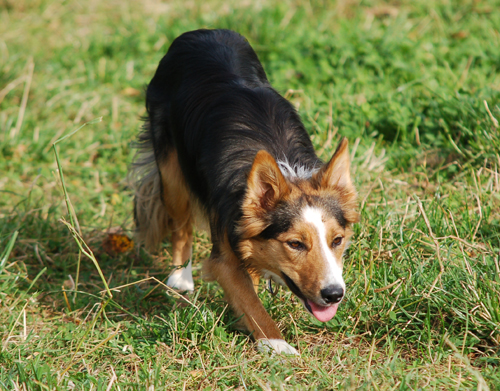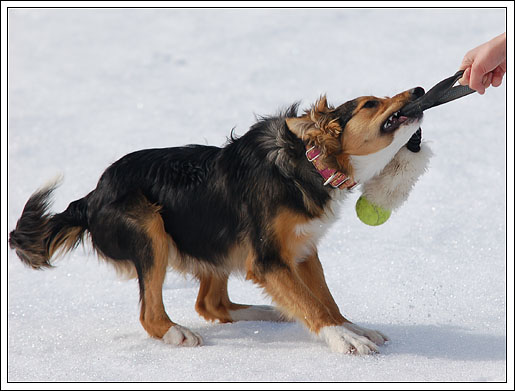
Go-outs
A few people asked me to write something about go-outs, so I’ll give it a try.
In FCI obedience, we have the send to a square. This is a good video that shows you how the exercise is done in the elite class. The dog is sent to a marker 10 meters (33′) in front of the handler where he is asked to stand. He is then sent abpout 23 meters (75′) to the left or right to a square made up by four marker cones. The outer limits of the square is marked with a visible line. The dog is told to stand in the square, then to lie down. The whole dog has to be inside the square to get points on the exercise. The handler walks towards the dog, turns to the side and then back to the start. About 10 meters from the start, the handler recalls the dog and the dog comes to heel. In the lower classes (class II and III) here in Sweden, the dog is sent straight ahead of the handler to the square. The Square is 10 meters away in class II and 25 meters away in class III.
In North America, the send out is across the ring, about 12 meters or 40 feet. (If I have read the regulations right, please correct me if I’m wrong). This is a good video of how the exercise is done. When the dog reaches the end of the ring, he is asked to sit and is then directed to either the left or the right jump, coming back towards the handler. When the dog is back at the handlers side, the exercise will be done again, this time doing the other jump.

I start working on send-outs early with young dogs. I want them to be comfortable and have fun with running full speed away from me. To get them started, I teach them to target a big mat (I often use car mats as they are a good size) with their paws and work on going out to the target. I want to focus more on the running out than on the targeting and try to place the reward in front of the dog. Always clicking and treating as the dog is targeting and turning towards the handler can create a dog that is always thinking about stopping, because all the value is in that behavior. When the target goes away, the dog will often stop short. I don’t use the target for much else than to make the puppy love running a long distance away from me, so I’m ok with the dog just running over the target. I try to mostly reward with a toy thrown over the dogs head as he is running away. I also leave the dog standing in front of me and send him to the target left or right, as in the send to square in elite class.
As I work on targeting, I also teach the dog to load when I restrain him by holding his collar (this can also be taught in other situations, like when doing crate games or teaching the dog to “get it”). When the target is out of the picture, the signal for the dog to go out will be me loading the dog by holding his collar.
Next step is to get the same behavior without a target. To get this, you can try different things. You could start by using the target and then taking it away in the same session. If the dog is excited and understands the collar load, he will probably start to go out even when the target is taken away. Reward him starting the go-out by throwing a toy over his head. You could also work on this while you’re out walking with your dog off leash. If your dog behaves likes to run straight forward when you release him after a recall, you could reward this with a thrown toy. After a few repetitions, add the collar grab and let the dog load before releasing him. Reward him for starting on a go-out and gradually increase the distance. Another way of getting the behavior is to throw a ball to the dog on a straight line, until the dog starts to anticipate the throw and runs away from you before you throw the ball. When the dog is getting the idea, start restraining him by the collar and work on longer and longer distances before you throw the ball.
All of these methods require that you have good mechanical skills. It is very easy to teach if you convince the dog right away that the easiest way to get the toy is to keep staring ahead. A lot of dogs have already learned to always look back at you in anticipation of the toy. This makes training a lot harder and I wold recommend that you keep the target for a longer time, so that you get a lot of repetitions where you can throw the toy over the dogs head without him ever looking back at you. You will probably need to stay close to the target and also sometimes reward the dog for actually targeting, so that he keeps his focus forward.
When I have a good send out to nothing, I add the square right in front of me and reward the dog for running straight through it. I then run to the square and play with the dog in the middle. I move the square a lot so that the dog is not just running on the same line over and over, and I make sure to vary the distance to the square all of the time. It usually doesn’t take long before you can see the dog getting excited by the sight of the square.
The dog also needs to know a good stop and a good down at a distance. This is something I train separatly, it’s a nice thing to work on while out for walk with the dog off leash.
There are a lot more things to say about the send to square, but I can’t write too long today, so this short text will have to do for now. What about the North American go-out then? Well. You can surely benefit from teaching your dog to run away from you in a straight line, but I would think that the easiest way to teach it is to teach the dog to just target the fence that marks the edges of the ring. It’s always there and it’s not a very long send. Combined with a well generalized “sit”, I don’t think you need to put much effort in to get a really nice performance.
Good luck with training and please comment below if you have any questions or comments.









